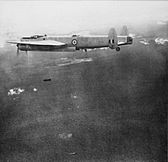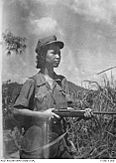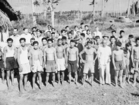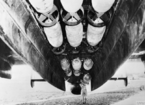Malayan Emergency facts for kids
Quick facts for kids Malayan EmergencyDarurat Malaya 馬來亞緊急狀態 மலாயா அவசரகாலம் |
|||||||
|---|---|---|---|---|---|---|---|
| Part of the decolonization of Asia and Cold War in Asia | |||||||
|
|||||||
|
|||||||
| Belligerents | |||||||
|
British Empire and Commonwealth forces:
Supported by: (Thai–Malaysian border) |
Communist forces:
|
||||||
| Commanders and leaders | |||||||
|
|
|
||||||
| Strength | |||||||
|
Over 451,000 troops.
|
Over 7,000 troops.
|
||||||
| Casualties and losses | |||||||
| 6,710 killed 1,289 wounded 1,287 captured 2,702 surrendered |
|||||||
| Civilians killed: 2,478 Civilians missing: 810 Civilian casualties: 5,000+ Total killed: 11,107 |
|||||||
The Malayan Emergency was a long fight in British Malaya from 1948 to 1960. It was also called the Anti–British National Liberation War. This conflict was a guerrilla war, meaning small groups used surprise attacks.
The main groups fighting were the Malayan National Liberation Army (MNLA) and the military forces of the Federation of Malaya, the British Empire, and the Commonwealth. The MNLA were communist fighters who wanted Malaya to be independent from British rule. They also wanted to create a socialist economy. On the other side, the Malayan Federation and Commonwealth forces fought to stop communism and protect British business interests. The British called it an "Emergency" instead of a "war." This was because insurance companies in London would not pay out money if it was officially a civil war.
Contents
The Start of the Conflict
The fighting began on June 17, 1948. Britain declared a state of emergency in Malaya. This happened after attacks on farms, which were revenge for earlier killings of activists.
Communist Fighters and Their Goals
The leader of the Malayan Communist Party (MCP), Chin Peng, and his allies went into the jungles. There, they formed the MNLA. Their goal was to fight for national liberation against British rule. Many MNLA fighters had experience from the Malayan Peoples' Anti-Japanese Army (MPAJA). This was a communist guerrilla army that the British had trained and armed to fight Japan during World War II.
The communists gained support from many civilians, especially from the Chinese community. The communists believed in class consciousness and equality for all ethnic groups and genders. This idea inspired many women and Orang Asli (indigenous people) to join the MNLA. They also joined the Min Yuen, a secret network that supplied the fighters. Some former Japanese soldiers also joined the MNLA.
Early Attacks by the MNLA
The MNLA set up bases in the jungle. From these bases, they started attacking British police and military sites. They also attacked mines, farms, and trains. Their aim was to make it too expensive for the British to stay in Malaya, hoping to win independence.
British Actions and Strategies
The British used several methods to try and defeat the MNLA. They tried to cut off the MNLA's food supply. This included rationing food, killing livestock, and spraying chemicals like Agent Orange from the air.
Controversial Tactics and Civilian Impact
Some British actions were very harsh. There were reports of British forces harming unarmed villagers without trial. A well-known event was the Batang Kali massacre. Some news reports compared it to the Mỹ Lai massacre that happened later in Vietnam.
The Briggs Plan was another major British strategy. It forced between 400,000 and 1,000,000 civilians to move into special camps called "New villages." Many Orang Asli communities were also forced into these camps. The British believed these groups were helping the communists.
After the Emergency Ended
The Malayan Emergency officially ended in 1960. However, the conflict was not completely over.
Continued Insurgency
Communist leader Chin Peng started fighting again in 1968. This second phase of the insurgency was against the new Malaysian government. It lasted until 1989.
Long-Term Effects and Investigations
The Indonesia–Malaysia confrontation (1963–66) happened because of tensions between Indonesia and the new Federation of Malaysia. Malaysia was formed after the Malayan Emergency.
Later, in the 1960s, news about the My Lai massacre during the Vietnam War led to investigations in the UK. People wanted to know about wrongdoings by British forces during the Malayan Emergency, like the Batang Kali massacre. So far, no British forces have been charged. The British government has often said these claims are just propaganda, even though there is evidence that some things were hidden.
After the Emergency ended in 1960, the MNLA, which was mostly made up of ethnic Chinese people, moved to the Malaysian-Thailand border. They regrouped and trained for future attacks. The new phase of fighting began on June 17, 1968. This was when the MCP attacked security forces in Kroh–Betong. This new conflict also happened during a time of tension between ethnic Malays and Chinese people.
Remembering the Conflict
Communist leader Chin Peng spent many years sharing his side of the story. He worked with academics and met with historians. This led to a book called Dialogues with Chin Peng: New Light on the Malayan Communist Party. He also wrote his autobiography, Alias Chin Peng: My Side of History.
Many old government papers, possibly about British actions in Malaya, were either destroyed or hidden. This was part of something called Operation Legacy. Some of these hidden documents were found during a legal case in 2011.
Images for kids
-
Commonwealth leaflet dropped in Malaya, offering a reward for a Bren gun.
-
Newspaper headline from 1952 about Chin Peng, called "Public Enemy No.1".
See also
- Batang Kali massacre
- Battle of Semur River
- Briggs Plan
- British Far East Command
- British war crimes#Malaya
- Bukit Kepong incident
- Chin Peng
- Cold War in Asia
- Communist insurgency in Malaysia (1968–89)
- Far East Strategic Reserve (FESR)
- History of Malaysia
- List of weapons in Malayan Emergency
- Malayan Peoples' Anti-Japanese Army
- New village















